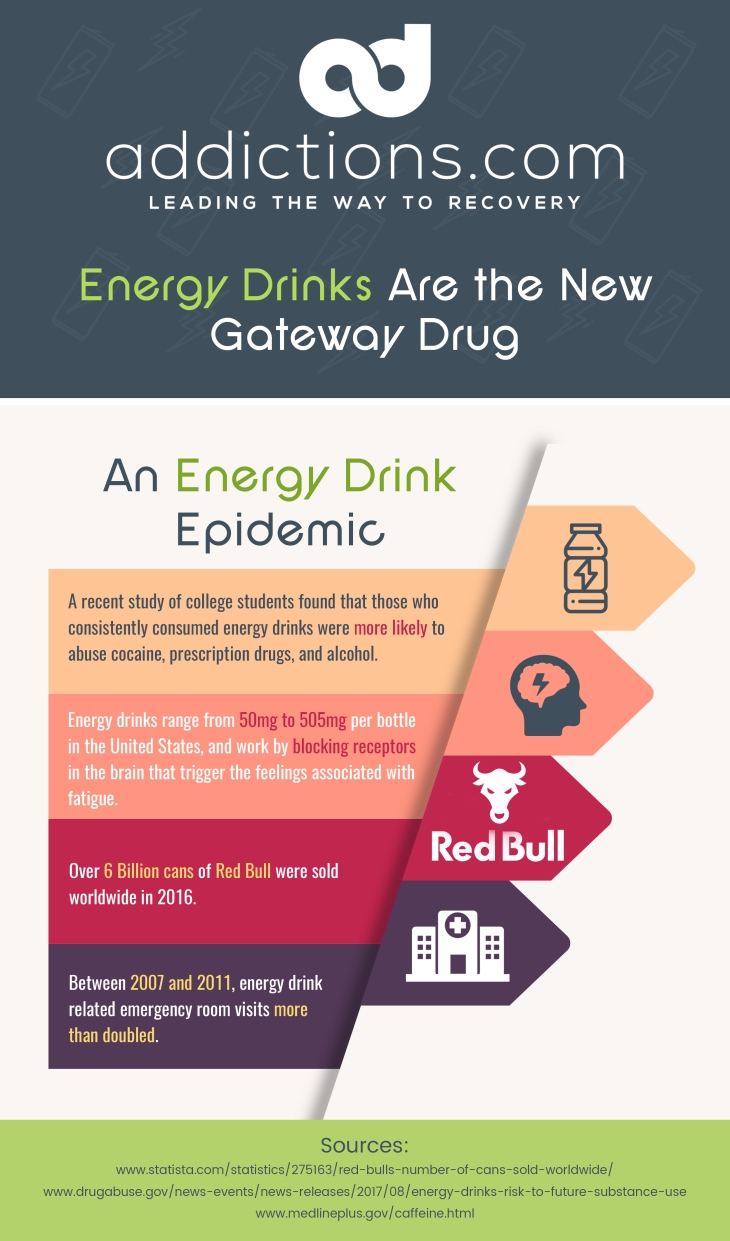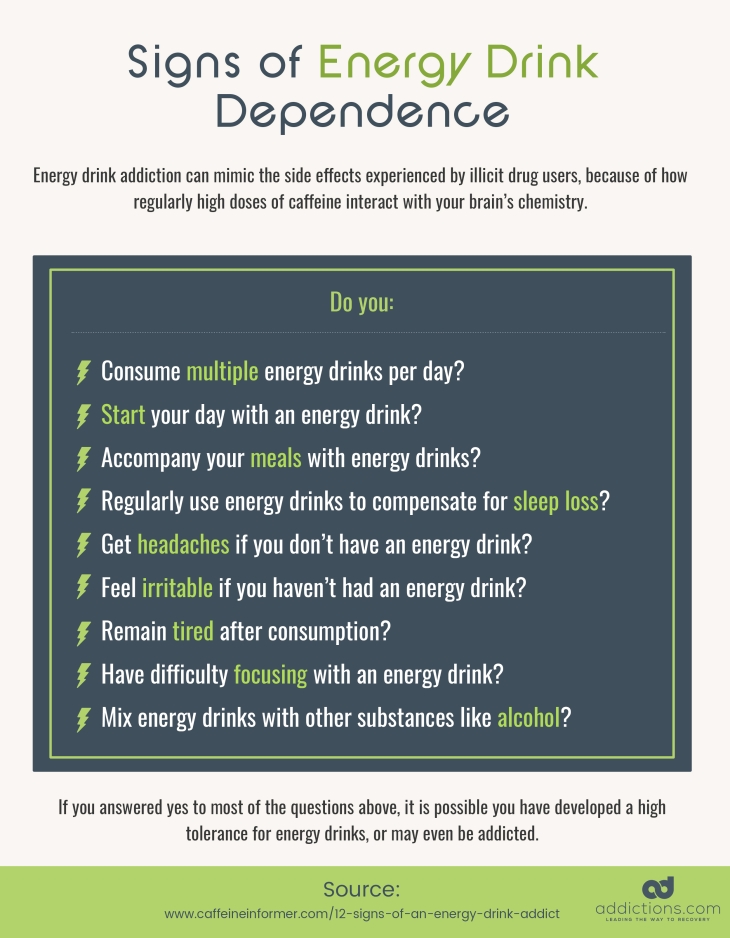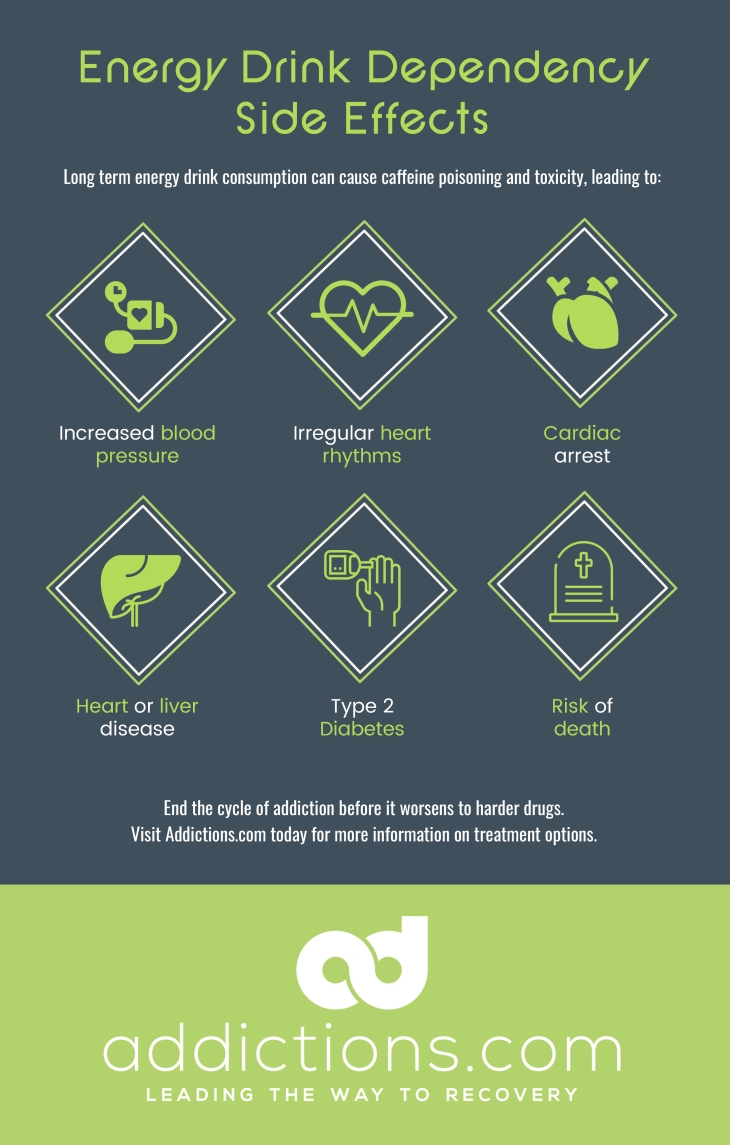Energy drinks can be found in most supermarkets, convenience stores, and vending machines across the United States. These high-caffeine beverages are marketed primarily at children and teens, and claim to improve alertness and endurance, and enhance physical and mental performance. A 24-ounce energy drink can contain up to 500 mg of caffeine, which is equivalent to the amount of caffeine found in roughly 14 cans of soda or several cups of coffee.
While the claims made by energy drinks may seem appealing — especially to children and teens who enjoy staying active — there is actually little to no existing scientific evidence that backs up these claims. In fact, energy drinks contain such a high amount of caffeine, that consuming these drinks regularly can lead to issues with caffeine tolerance, dependence, and addiction. In teenagers, energy drink abuse can cause permanent damage to brains still in development, and can lead to the use of more potent, addictive stimulants including prescription drugs like Adderall and Ritalin, and illicit drugs like cocaine.
Energy drink addiction is real, and may unknowingly be affecting you, your children, and others who consume these beverages on a regular basis. Here’s what you need to know about the link between energy drinks and addiction, and how these beverages can serve as the gateway drug to cocaine and other dangerous substances.
When Did Energy Drinks Become Popular?
Energy drinks exploded onto the U.S. market beginning 1997 with Red Bull. Red Bull was created in Austria in 1987, and is currently the top selling energy drink in the U.S. and entire world. In 2016 alone, more than six billion cans of Red Bull were sold internationally.
Following in Red Bull’s footsteps were energy drink brands Rockstar, Monster, and 5-Hour Energy, which hit the U.S. market in 2001, 2002, and 2003, respectively. Sales of energy drinks in the U.S. rose 60 percent from 2008 to 2012, increased by over five percent from 2015 to 2016, and are projected to continue rising in future years. A study conducted on U.S. drinking trends among youth found that over 42 percent of kids between the ages of 11 and 18 consume energy drinks at least once every two weeks. Another study found that worldwide, approximately 68 percent of teens and 18 percent of kids under the age of 10 consume energy drinks regularly.
Most energy drinks are marketed primarily to male youth, and are advertised to offer countless benefits when it comes to improving one’s energy, endurance, and attention span. Many slogans and taglines for energy drinks associate the beverages with having fun and excelling at sports or academics, which make these drinks particularly appealing for male youth. Men between the ages of 18 and 34 consume the highest percentage of energy drinks compared to the rest of the population.
Teens and young adults in college frequently mix energy drinks with alcohol to mask the taste of liquor, and to stay awake through long nights of drinking and partying. The alcohol-energy drink combination comes with many risks, since research shows that this mixture can make individuals feel less intoxicated than they truly are, and ups the risk for alcohol poisoning. A study published in PLOS One even found that mixing alcohol and energy drinks produces effects similar to that of cocaine which only fuels the risk for problems with intoxication and addiction among the youth population.
How Can Energy Drinks Lead to Cocaine Use?
Energy drinks are high in caffeine, which is a natural stimulant found in coffee and tea. Caffeine heightens alertness to help you feel less tired and more awake, and is even used as an ingredient in many prescription medications to treat conditions like fatigue and migraines. The FDA reports that caffeine is not harmful when consumed in moderation, and that sticking to between 100 and 200 mg of caffeine per day offers no serious health risks.
Energy drinks sold in the U.S. contain anywhere from 50 mg to over 500 mg of caffeine, depending on the brand, flavor, and serving size. Brands that contain the highest amount of caffeine include 10 Hour Energy Drink with 422mg in every 2ounces, Redline with 316 mg in every eight ounces, Spike Shooter with 300 mg in every 8.4 ounces, and 5 Hour Energy Drink with 200 mg in every 2 ounces. Since there are no laws or regulations in the U.S. surrounding energy drink purchases, children and teens can simply walk into any grocery store and buy the energy drinks of their choice, regardless of how much caffeine they contain.
Many energy drinks contain more than the daily recommended amount of caffeine. Consuming energy drinks regularly can increase one’s caffeine tolerance, and eventually deaden the effects produced by their usual caffeine intake. Energy drink consumers who become tolerant to caffeine will start drinking a higher amount more frequently in an effort to achieve the same effects.
When tolerance becomes part of the equation, those who consume energy drinks may turn to other more powerful stimulants that produce effects similar to those of caffeine. One study published in the journal Drug and Alcohol Dependence found that young adults who consumed high amounts of energy drinks were at greater risk for abusing alcohol, and for becoming addicted to cocaine and other stimulants within five years. Drugs in the stimulant class include prescription drugs used to treat ADHD like Adderall, Ritalin, and Concerta, and illicit drugs methamphetamine, Ecstasy/MDMA, and cocaine. These highly addictive drugs can eventually lead to physical dependence, and serious problems with addiction that can negatively affect one’s overall health and livelihood.
How Are Energy Drinks and Cocaine Alike?
Energy drinks and cocaine are both stimulants that produce similar effects such as alertness and increased energy. A caffeine buzz generally takes up to an hour to kick in after ingestion, and lasts of average of between three and six hours. Cocaine produces rapid effects in just under 30 minutes, and brings on intense feelings of euphoria, elation, heightened self-esteem, and increased energy levels.
Cocaine can also produce irritability, anxiety, restlessness, and feelings of panic and paranoia. A cocaine high may last as little as five minutes, or as long as an hour. Many times, this leads to binge-use so users can maintain the strong effects of cocaine.
Energy drinks and cocaine are considered addictive substances due to the way they increase production of a brain chemical known as dopamine. Dopamine is responsible for regulating feelings of reward and pleasure, and is naturally produced by your brain when you get plenty of quality sleep, practice good nutrition, and exercise regularly. Those who consume energy drinks and use cocaine will experience a rise in dopamine every time they use these substances.
Unfortunately, abusing stimulants like energy drinks and cocaine can prevent the brain from producing dopamine naturally on its own. A person becomes physically dependent and/or addicted to energy drinks and cocaine when the brain starts relying on these substances to experience a rise in dopamine.
Dangers Surrounding Energy Drink Abuse
Energy drinks sold in the U.S. are not required to have labels that warn against the potential dangers of consuming these powerful, high-caffeine stimulants. While the FDA requires that over-the-counter medications with at least 100 mg of caffeine include warning labels on their packaging, energy drinks that contain at least 500 mg of caffeine are not required to have the same warnings. Many times, consumers are left in the dark about the amount of caffeine they’re ingesting when having energy drinks.
Caffeine Intoxication
Abusing energy drinks can increase one’s risk for caffeine toxicity, or overdose. Energy drink side effects are often more intense in youth, since children and teens generally have a lower caffeine tolerance than most adults. Children and teens who abstain from consuming caffeine, or who consume caffeine in lower amounts such as that found in soda, tea, and coffee can easily suffer caffeine toxicity after having just a few energy drinks.
Common symptoms of caffeine intoxication:
- Restlessness
- Tremors
- Nervousness
- Insomnia
- Anxiety
- Nausea
- Vomiting
- Constipation
- Diarrhea
- Rapid heart rate
- Chest pain
Some cases of caffeine intoxication have even led to seizures, stroke, heart failure, and death.
Long-Term Effects of Caffeine Abuse
Those who become tolerant to energy drinks and who abuse these stimulants long-term are at heightened risk for a wide range of serious health problems. Energy drink abuse puts undue stress on the body that can accelerate the aging process, and lead to:
- Ulcers
- Dehydration
- Headaches and migraines
- Insomnia
- Anxiety
- High blood pressure
- Heart attack
- Stroke
- Damaged adrenal glands
- Osteoporosis
Signs of Energy Drink Addiction
If you or a loved one consumes energy drinks regularly, look for the following signs that indicate it may be time to get help for energy drink addiction:
- You rely on energy drinks for a pick-me-up.
- You are late to school or work due to buying energy drinks.
- You consume an energy drink first thing every morning.
- You consume multiple energy drinks throughout the day.
- You become irritable, anxious, or stressed when you cannot have an energy drink.
- You spend at least $20 per week on energy drinks.
- You consume energy drinks to make up for lack of sleep.
- You hide energy drink consumption from friends and family.
- You lie about the number of energy drinks you consume.
- You are unable to focus or pay attention without having an energy drink.
- You suffer caffeine withdrawal symptoms.
- You still feel tired and fatigued after drinking your usual amount of energy drinks.
Addiction of any type can be effectively treated — including energy drink addiction. If you or a loved one is suffering from addiction, understand it’s never too late to get help, and that seeking treatment can prevent caffeine dependence from turning into a more serious addiction.
Dangers Associated with Cocaine Use
Cocaine is the fourth most addictive drug in the world, and causes a high number of drug overdose deaths in the U.S. Since cocaine use alters brain structure and dopamine levels, cocaine use among children and teens increases the risk for problems with motor skills and behavioral health conditions. This is mainly because teenagers’ brains are still in development, and lack the nerve connections needed to fully recover from the effects of cocaine.
Here are some of the long-term effects associated with cocaine use:
- Ulcers
- Loss of appetite
- Loss of sense of smell
- Regular nosebleeds
- High blood pressure
- Extreme weight loss
- Difficulty with swallowing
- Malnutrition
- Stroke
- Parkinson’s disease
- Memory loss
- Gum disease and tooth loss
- Increased risk for heart attack and stroke
- Increased risk for HIV and AIDS
- Blood vessel damage
- Vein infections
- Liver damage
- Lung damage
- Kidney damage
- Panic attacks
- Paranoia
- Psychosis
Cocaine addiction is commonly treated using detoxification and psychological therapies that address root causes of addiction. To help individuals get safely and comfortably through withdrawal, many drug rehab centers prescribe medications that relieve common cocaine withdrawal symptoms such as runny nose, congestion, and anxiety. Following cocaine detox, patients can benefit from counseling and behavioral therapies that teach them how to navigate the real world without having to rely on cocaine for stimulation.
Getting Help for Energy Drink Addiction
Caffeine and energy drink addiction are legitimate, serious health conditions that can interfere with your education, career, and personal life goals. Fortunately, these addiction types can be effectively treated at facilities that specialize in drug and alcohol abuse.
Therapies such as cognitive-behavioral therapy can help you identify and overcome negative thoughts and behaviors that influence your need for energy drinks, while support group therapy allows you to connect with others who are also overcoming addiction to stimulants. Drug rehab centers will also help you establish a new daily routine filled with exercise and other healthy activities that replace energy drink abuse, and that help eliminate your urges for caffeine.




